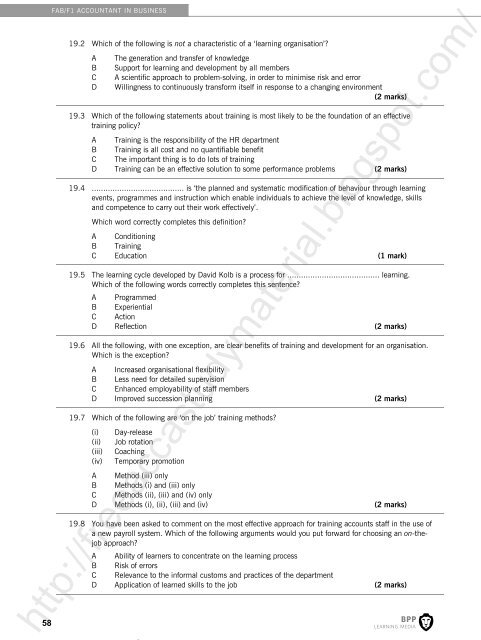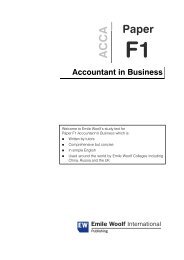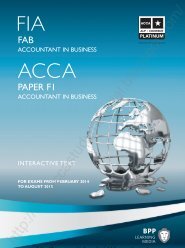FIA ACCA
Create successful ePaper yourself
Turn your PDF publications into a flip-book with our unique Google optimized e-Paper software.
58<br />
FAB/F1 ACCOUNTANT IN BUSINESS<br />
19.2 Which of the following is not a characteristic of a ‘learning organisation’?<br />
A<br />
B<br />
C<br />
D<br />
The generation and transfer of knowledge<br />
Support for learning and development by all members<br />
A scientific approach to problem-solving, in order to minimise risk and error<br />
Willingness to continuously transform itself in response to a changing environment<br />
(2 marks)<br />
19.3 Which of the following statements about training is most likely to be the foundation of an effective<br />
training policy?<br />
A Training is the responsibility of the HR department<br />
B Training is all cost and no quantifiable benefit<br />
C The important thing is to do lots of training<br />
D Training can be an effective solution to some performance problems (2 marks)<br />
19.4 ........................................ is ‘the planned and systematic modification of behaviour through learning<br />
events, programmes and instruction which enable individuals to achieve the level of knowledge, skills<br />
and competence to carry out their work effectively’.<br />
Which word correctly completes this definition?<br />
A Conditioning<br />
B Training<br />
C Education (1 mark)<br />
19.5 The learning cycle developed by David Kolb is a process for ........................................ learning.<br />
Which of the following words correctly completes this sentence?<br />
A Programmed<br />
B Experiential<br />
C Action<br />
D Reflection (2 marks)<br />
19.6 All the following, with one exception, are clear benefits of training and development for an organisation.<br />
Which is the exception?<br />
A Increased organisational flexibility<br />
B Less need for detailed supervision<br />
C Enhanced employability of staff members<br />
D Improved succession planning (2 marks)<br />
19.7 Which of the following are ‘on the job’ training methods?<br />
(i)<br />
(ii)<br />
(iii)<br />
(iv)<br />
Day-release<br />
Job rotation<br />
Coaching<br />
Temporary promotion<br />
A Method (iii) only<br />
B Methods (i) and (iii) only<br />
C Methods (ii), (iii) and (iv) only<br />
D Methods (i), (ii), (iii) and (iv) (2 marks)<br />
19.8 You have been asked to comment on the most effective approach for training accounts staff in the use of<br />
a new payroll system. Which of the following arguments would you put forward for choosing an on-thejob<br />
approach?<br />
A Ability of learners to concentrate on the learning process<br />
B Risk of errors<br />
C Relevance to the informal customs and practices of the department<br />
D Application of learned skills to the job (2 marks)<br />
http://freeaccastudymaterial.blogspot.com/





